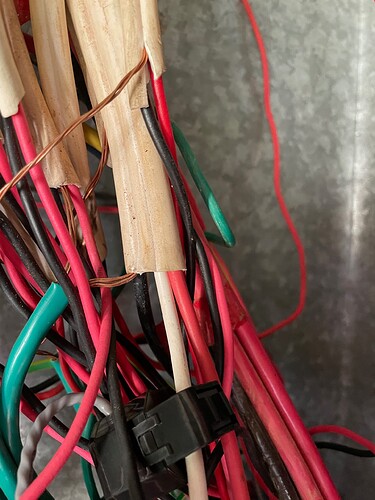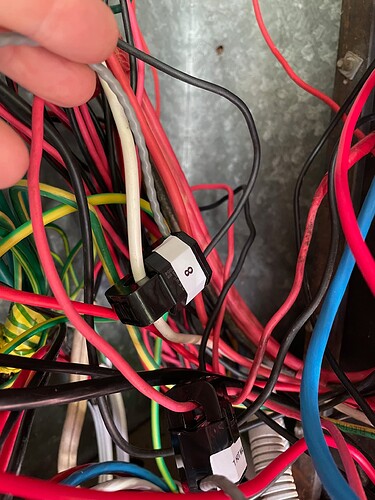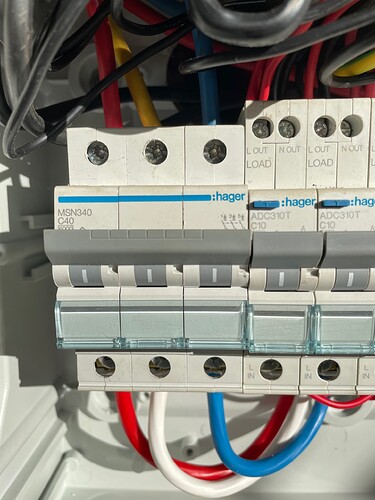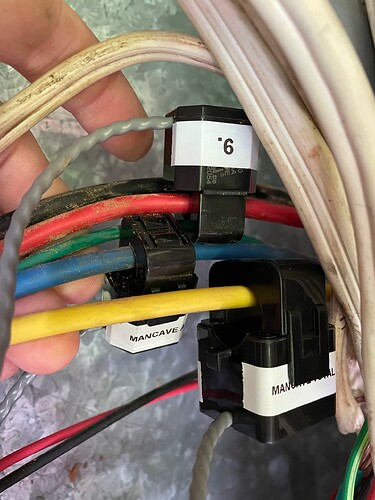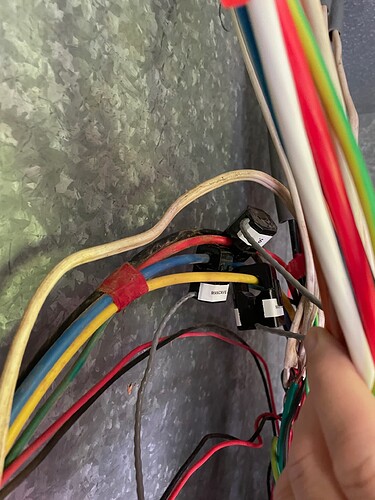Thanks for responding.
Your initial thoughts are along the right path.
But my set up is not quite normal. So brace yourself, this will be long…
The normal bit:
Our wire colours are different to the US, and they have changed over time. My home is old enough (50 years) to have a mix but mostly follows the typical colour codes used here for last few decades:
Single phase circuits it’s:
green/yellow or bare wire = earth
black = neutral
red = active
3-phase it’s:
yellow/green = earth
black = neutral
red, white, blue = active
While the two phase supply (to oven and induction stove) uses the red and white as actives.
Here you can see the wider sheath in the middle of the picture with the bare wire (earth), black (neutral) and the red (oven) and white (induction stove) wires:
In the above pic I pushed the CT up along the wire a little to get it into shot. The CT (allowed to drop down the wire a little from the above photo) is around the white (induction stove) wire only:
That CT is set to use the WHITE phase VT reference.
The colour code exception is the power supply cable to the mancave which use yellow instead of white. I confirmed this by looking at the 3-pole breaker used for that:
Red, white, blue IN
Red, yellow, blue OUT
Here are the wires supplying my mancave, each with its own CT:
and here you can see them taped together, and a little further down they enter a sheath/conduit together like that:
Now the not so normal bit:
My home is supplied by a hybrid of grid and off-grid supply.
Circuits are split into two broad groups:
NON-ESSENTIAL: Those not covered by the off-grid supply
ESSENTIAL: Those covered by the off-grid supply
The NON-ESSENTIAL circuits includes electric water heater, ducted aircon, large split system aircon, oven, induction stove, 3-phase grid tied PV inverter, pool pump, and the input supply to the off-grid inverter (which itself can pass through grid power), plus the power outlets used by the VTs for the RED and WHITE phases. NON-ESSENTIAL circuits are only ever supplied by the grid power supply. If the grid is down, so are they.
The ESSENTIAL group is everything else, all power and light circuits and including supply to the two outbuildings and the power outlet used by the VT for BLUE/OFF-GRID phase and the power supply for the IotaWatt.
A break before make 3-phase transfer switch is in place such that when in the grid supply position, all circuits are powered by the grid supply and via whatever phase they are normally connected to. In this scenario if the grid goes down, nothing has power.
When the transfer switch is in the off-grid/backup position, then ESSENTIAL circuits are moved over to the off-grid supply. It’s just like having a backup generator set up. Meanwhile the NON-ESSENTIAL circuits continue to be powered via the regular grid supply.
In effect I have two isolated sets of circuits operating.
The phases of the off-grid supply side of the transfer switch are all tied together so as to form a single phase supply for all those circuits.
My normal mode of operation is to have the transfer switch in the off-grid position. It would only be placed back into the grid-only position if my off-grid system needed service.
The off-grid supply can supply/generate its own power (via a small off-grid PV array and a battery) but it can also pass the grid supply through (and its AC input is supplied via the BLUE phase). That is a remotely controllable setting managed by my Home Assistant automations.
Typically, the off-grid inverter passes through grid power during the daytime (as my grid-tied PV array and Fronius Symo inverter covers consumption), while in the late afternoon/early evening when the grid-tied PV is no longer able to cover consumption the off-grid system ceases passing grid power though and swaps over to power the home via the battery (which was being charged during the day by the off-grid PV array, and sometimes a bit of supplemental charging from the grid supply if there is spare grid-tied PV capacity). It’s all managed by Home Assistant automations.
So while I have two outbuildings which are supplied via 3-phase five wire cable (an earth, a neutral and the three actives), most of the time the power being delivered over the three actives is not 3-phase (with normal 120° phase angle separation), but rather the three actives are tied together as a single phase supply.
Hence the expectation a CT can cover more than one wire to the outbuildings.
